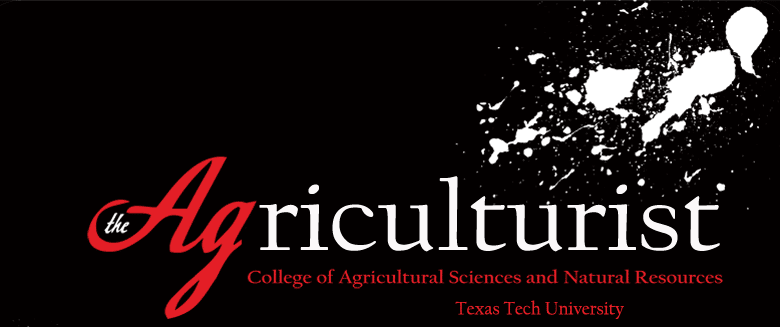
Table of Contents
Features
Agriculture: We Can Sustain It
Socializing Agriculture
Painter of Quiet Places
An Apple a Day
Sustaining the Four Sixes
Hitting Pay Dirt
The New Face of Agriculture
The Winds of Change
Avatars Animate Agriculture
Professors in Training
Going Green
Saving Lives One Plan at a Time
Protecting Our Food
Quality Cells, Consumer Buys
Tech's New Mate
Micro ZAP
Food Saftey in Mexico
Expanding Opportunities
No Bits About It
The Family Farm Fire Man
Around the World with CASNR
Live From Texas Tech
Looking Forward
Getting Schooled
A Cotton Senstaion
Living and Learning
More Than a Trophy
Online Exclusives
Alumni Lance Barnett: Unpeeled
Agricultural Education and CommunicationDepartment Shines in 2010
CSI: Classroom Soil Investigation
Facing Nature
GINuine
Healing Hooves
Parking and Partying in Style
Raider Red Meats
Standing TALL
Tech Takes Flight
West Texas Cotton Goes Global
Food Saftey In Mexico
By Holly Hunnicutt
Ever wondered where the meat you buy at the grocery store comes from? Is the meat fresh? Is the meat safe? What if it comes from Mexico, where a majority of the meat from local slaughtering plants are not completely inspected like in the U.S.? With over 649 million pounds of beef being imported into the United States from Mexico, food safety is a major concern in the food industry.
In Mexico, food-borne disease is one of the leading causes of death in children. Since the U.S. relies heavily on international trade and Mexico is the largest importer of American beef and variant meat, Texas Tech University has put together a team to test the food contamination and unsanitary practices in food processing in Mexico.
A team that includes food microbiologists, meat scientists, and an epidemiologist was assembled to conduct the research. The team represents scientists from Texas Tech, West Texas A&M University and Facultad de Medicina Veterinaria y Zootecnia in Mexico.
The team established a collaborative relationship over several months by interacting with the meat industry in Mexico on current food safety issues. The team has been traveling to several cities in Mexico to test the meat from local supermarkets, city markets, street vendors and butcher shops.
Kevin Pond, chair of the Department of Animal and Food Sciences, said, “There are several master’s students that have been traveling with Mindy Brashears to Mexico to collect data and samples to take back and test for their theses.”
“There has been minimal research conducted in the food chain in Mexico which is creating problems between government officials and the industry,” said Ansen Pond, research team member. “Due to the lack of information, food safety regulations in Mexico are not implemented by a majority of slaughter facilities and there are currently no regulations for retail outlets.”
With the heightened need for establishment baseline for effective evaluation, the team has conducted a study to determine the contamination of E.coli and salmonella in beef and pork products.
Currently the only food safety regulations monitored by the Mexican government and other food safety programs in Mexico is the “Tipo Inspeccion Federal” (TIF). Additionally, the team developed a baseline of indicator organisms, specifically generic E. coli and coliforms.
While the team traveled to different plants around Mexico collecting sample swabs, Mexican government worked with the team to learn how to implement sanitary manufacturing practices in slaughter and harvesting plants. Determining the prevalence of E. coli and salmonella allows for the establishment of a baseline, which would allow for the determination of the efficiency of food safety programs currently implemented in Mexico.
Ansen Pond explained that TIF plants are similar to American slaughter plants that are monitored by the United States Department of Agriculture. Slaughter plants regulated by TIF export meat products to other countries and supply products only to supermarkets in Mexico. Non-TIF regulated plants supply meat products to vendors such as city markets, butcher shops and street vendors throughout Mexico.
Most non-TIF slaughter plants lack good manufacturing practices and have poor hygienic conditions during food processing. Those conditions are due to the unregulated status and results in an unsafe food supply.
Kevin Pond emphasized that the export of meats to Mexico is very important, due to the fact that many cuts deemed undesirable in the Mexican market are considered premium cuts in the U.S., and undesirable cuts in the U.S. are valuable to the Mexican market. This relationship, based on cultural differences and differentiated eating habits, makes trade desirable and profitable for American and Mexican beef producers.
“The plants in Mexico worked well with our team coming in and taking samples,” Kevin Pond said, “Because they knew that we were working toward helping them to develop sanitary practices throughout Mexico. They trusted our team more than they trusted their own university to do the studies.”
With the data collected researchers are finding out that all of the markets and vendors from the samples taken from the different towns in Mexico have some form of salmonella and E.coli. This information has helped the Mexican government to implement TIF regulations in the slaughter plants that will be exporting to the U.S. and other countries. These regulations will also help to maintain a sanitary environment in the slaughter plants as well.